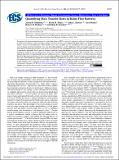Quantifying Mass Transfer Rates in Redox Flow Batteries
Author(s)
Milshtein, Jarrod D; Tenny, Kevin M; Barton, John L; Drake, Javit; Darling, Robert M; Brushett, Fikile R; ... Show more Show less
DownloadPublished version (1.043Mb)
Terms of use
Metadata
Show full item recordAbstract
© The Author(s) 2017. Engineering the electrochemical reactor of a redox flow battery (RFB) is critical to delivering sufficiently high power densities, as to achieve cost-effective, grid-scale energy storage. Cell-level resistive losses reduce RFB power density and originate from ohmic, kinetic, or mass transfer limitations. Mass transfer losses affect all RFBs and are controlled by the active species concentration, state-of-charge, electrode morphology, flow rate, electrolyte properties, and flow field design. The relationship among flow rate, flow field, and cell performance has been qualitatively investigated in prior experimental studies, but mass transfer coefficients are rarely systematically quantified. To this end, we develop a model describing one-dimensional porous electrode polarization, reducing the mathematical form to just two dimensionless parameters. We then engage a single electrolyte flow cell study, with a model iron chloride electrolyte, to experimentally measure cell polarization as a function of flow field and flow rate. The polarization model is then fit to the experimental data, extracting mass transfer coefficients for four flow fields, three active species concentrations, and five flow rates. The relationships among mass transfer coefficient, flow field, and electrolyte velocity inform engineering design choices for minimizing mass transfer resistance and offer mechanistic insight into transport phenomena in fibrous electrodes.
Date issued
2017Department
Massachusetts Institute of Technology. Department of Materials Science and Engineering; Massachusetts Institute of Technology. Department of Chemical EngineeringJournal
Journal of The Electrochemical Society
Publisher
The Electrochemical Society